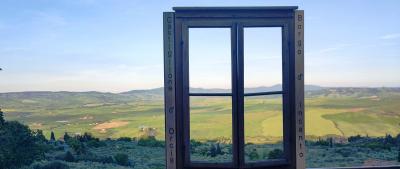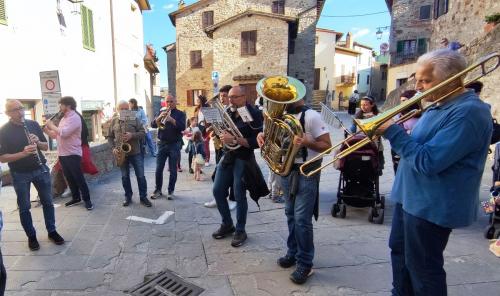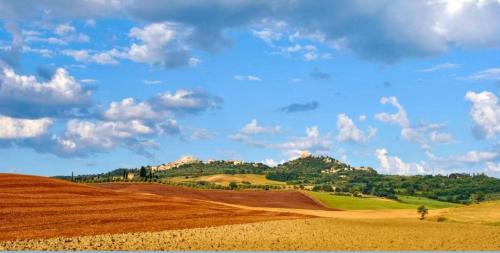Val d'Orcia, the Maggiaioli bloom in May

VAL D'ORCIA — May in Italy is a month of great popular traditions which find expression in villages and cities to celebrate the peak of the spring season. Among the most interesting areas,Val d'Orcia in Tuscany is second to none for the richness and pleasantness of these traditions. One of the key locations in this valley is the village of Castiglione d'Orcia.
Situated on the top of a hill, as its name indicates, there is an ancient castle which saw its development thanks to its strategic location on the Via Francigena. For centuries the stronghold of the Aldobrandeschi family, the Rocca Aldobrandesca rises above the village, where the imposing keep, the walls and other rooms can be visited.
The ancient town hall overlooks the picturesque Piazza Vecchietta which owes its name to the painter Lorenzo di Pietro, known as Vecchietta, who was long thought to be a native of here. A few steps from the square, the Church of Santi Stefano e Degna houses a valuable panel by the Sienese painter Pietro Lorenzetti.
A municipality since 1252, at different times it annexed the surrounding villages to its territory until it assumed its current characteristics in 1867, for this reason it boasts a richness and variety of environments and locations: Campiglia d'Orcia, Gallina, Vivo d'Orcia and the spa area of Bagni San Filippo while, right in front of Castiglione, in the shadow of the Tentennano Tower, is the small medieval village of Rocca d'Orcia. The town has the typical conformation of villages of medieval origin, and welcomes you with its history and its traditions, a glimpse of a true and authentic Tuscan reality and set in an extraordinary landscape.
A short walk in the historic center can include a visit to the Sala d'Arte San Giovanni, a small but well-kept museum that collects paintings by some of the major exponents of the Sienese school of the fourteenth and fifteenth centuries: Simone Martini, Lorenzo di Pietro known as il Vecchietta and Giovanni di Paolo, with three splendid Madonnas and Child.
Continuing the walk, between April 30th and May 1st, you may come across a group of singers and musicians (about twenty), who wander around the villages of Castiglione and Rocca d'Orcia, travel through the countryside visiting the farms, different every year, singing octosong quatrains that wish the return of the good season, of good harvests and that sing of love and the awakening of nature. Each quatrain is followed by a piece of music performed by a small fanfare of instruments.
In exchange the singers and musicians called "Maggiaioli" receive hospitality, wine, food and monetary offerings. The "tour" ends every year in the village of Castiglione d'Orcia: the Maggiaioli walk through the streets of the town until the morning of May 1st. The monetary offerings that the singers collect during the alms, carried out in the following weeks, are used, at a later time, to set up a snack open to the entire population, but the food and wine tradition of the area deserves a separate report.
The structure of the town is concentrated around the fortress and the keep, which dominate the village from a hill below, also defended by another wall circuit. The first attestation of the castle within the Codex Diplomaticus Amiatinus seems to date back to 1014 when it was mentioned with the name of Petra, but already in 1094 it was called Castelione, as shown in a donation document from the Aldobrandeschi to the abbey of San Salvatore al Monte Amiata. In the first half of the 14th century, Castiglione attracted the expansionist aims of Siena, which was increasingly intent on controlling important traffic areas such as the Val d'Orcia.
Between 1301 and 1303 the castle was sold by the Aldobrandeschi to Siena who carried out a series of building interventions with the aim of making the place an impregnable "sentinel.”
Between 1368 and 1419, the new Sienese fortress was given as a reward to the noble Salimbeni family who used it as a stronghold to spread their lordship within the Val d'Orcia, managing to exercise there, together with the nearby Rocca di Tentennano, a strong control until they were defeated by the Republic of Siena, which once again restored and repaired the keep and the fortifications of the village. However, none of these interventions managed to guarantee a good defense for the town, which was forced to face the advance of Florence together with the other castles in the valley until 1559, when, with the peace of Cateau-Cambrésis, the vast Sienese territory became part of the Grand Duchy of Florence.
In 1605 Castiglione d'Orcia was transformed into a fiefdom of the Marquis Giulio Riario, who had a large palace built on the remains of the fortress, already mentioned in the eighteenth century as being in a state of abandonment. After a long restoration, the fortress was opened to the public in August 2023.
A visit to the hamlets and areas of the town suggests a trip to Vivo d'Orcia and a visit to the Ermicciolo springs: a rich network of paths allows a dive into nature among chestnut trees and silver firs. Vivo d'Orcia rises around two Camaldolese hermitages founded by Saint Romualdo around the year one thousand. Downstream is the hermitage of San Pietro whose monastery was incorporated into the Palazzo Cervini built by Antonio da Sangallo for Pope Marcellus II; upstream the upper hermitage of San Benedetto all'Ermicciolo.
Here flow the sources of the stream whose waters feed the entire territory up to Siena. Continue to Campiglia d'Orcia, a town with the typical conformation of medieval villages, suggestive alleys, narrow connecting stairways and covered paths. To discover its historic center, a walk highlights the points of historical, landscape and memory interest. Higher up, reachable by a path, stands the thirteenth-century Torre di Campigliola. Legend has it that the tower was inhabited by fairies who helped the farmers in June by harvesting the wheat at night.
Here we recommend a lunch break at the Campotondo winery where you can taste the good DOC Orcia wine, to continue to Bagni San Filippo and the Balena Bianca with a stop at the San Filippo cave. Known since ancient times, this spa town represents a true connection between Vald'Orcia and Amiata.
Near the village a thermal river, the "white ditch", flows into the green of the forest until it reaches a waterfall of hot water which gives rise to the White Whale, a spectacular formation of limestone which recalls, in its shape and colour, Melville's famous Moby Dick. Continuing towards Gallina, the town has been in a strategic position since the past, near the Via Francigena. Witnesses to this are the post stations, ancient hospices for pilgrims and travelers, della Scala and Briccole.
Short walk (easy 2 km) towards the Briccole along the Via Francigena in the places that saw the passage of the Archbishop of Canterbury Sigeric, where the Countess Matilde of Canossa stopped, the heretic Arnold of Brescia was captured, took place, according to tradition, the Mystical Wedding of Saint Francis with Madonna Povertà represented in the 1450 panel by Sassetta. On the way back to the municipal capital, a photo stop at the cypresses of Poggio Covili. Continuing the visit, the Rocca d'Orcia and the Tower of Tentennano are unmissable. The tiny village retains all its medieval characteristics and is guarded by the imposing Tower of Tentennano which dominates the entire Val d'Orcia. In 1207 in the village, for the first time in history, a charter was issued which established the duties and rights of the people towards the feudal lords, the Charta Libertatis. The writings tell us that in 1377, Saint Catherine of Siena stayed there and received the divine gift of writing right here, as an illiterate.
Sustainable tourism through word of mouth
The mayor of Castiglione for a decade, Claudio Galletti, is keen to underline the great social and economic development that has occurred in the valley since the post-war period, stimulated by tourism which, however, cannot and must not upset the rhythm of human life and faithful to the traditions of the entire environment and the people who inhabit it. The widespread hospitality in the villages of the area, achieved thanks to the renovation of houses, has created a form of hospitality which, after the pandemic, has had a good development, with a form of hospitality which, underlines the mayor, spreads through word of mouth and certainly not with large platforms. “Whoever comes here is a guest of a family, and it is a different formula from hotel hospitality which is not available here”. In recent times, foreign tourism has been growing, including Asian tourists: "we have around sixty agriturismos and around 800 beds" adds the mayor "but we are keen not to chase mass tourism". The Val d'Orcia is, ultimately, the ideal but also real Tuscany, and it is therefore no wonder that in 2004 the incredible panorama of the valley was declared a World Heritage Site by UNESCO (gn)
Further information: castiglionedorcia.siena.it comune.astiglionedorcia.siena.it visitvaldorcia.it


© COPYRIGHT ITALIAN INSIDER
UNAUTHORISED REPRODUCTION FORBIDDEN


